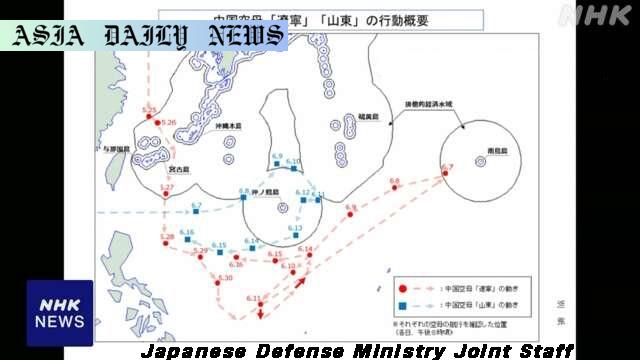Chinese Aircraft Carriers: Japan publishes routes of Liaoning and Shandong operations creating serious concerns over regional security.
- Chinese Aircraft Carriers Liaoning and Shandong navigated Japan’s waters.
- Around 780 flight operations were observed, raising security concerns.
- Japan’s Defense Ministry is closely monitoring the situation.

Introduction: Increased Chinese Naval Activities
In a rare move showcasing heightened regional sensitivity, Japan’s Defense Ministry has released information regarding the routes taken by the Chinese aircraft carriers Liaoning and Shandong. These vessels, which were operating in the waters surrounding Japan from late May to June this year, executed a combined total of approximately 780 flight operations during a span of just a few weeks. This disclosure underscores the intensification of China’s maritime presence in the region and Japan’s concerns over national and regional security.
Details on Liaoning and Shandong’s Movement
The Liaoning aircraft carrier was first noted passing between the main island of Okinawa and Miyakojima Island in late May. From there, it ventured southward to a position east of the Philippines before dramatically altering its course northeast, entering Japan’s Exclusive Economic Zone (EEZ) near Minamitorishima Island on June 7. This period saw extensive activities onboard the Liaoning, with aircraft, fighter jets, and helicopters reportedly taking off and landing over 550 times.
The Shandong aircraft carrier pursued an equally active route, first heading eastward southeast of Miyakojima Island on June 7, later moving in a clockwise manner inside or around Japan’s EEZ near Okinotorishima Island. By June 12, the ship was observed moving in a westerly direction southeast of Miyakojima. During this time, Japan’s Defense Ministry recorded a total of approximately 230 take-offs and landings by air-based units associated with Shandong.
Japan’s Escalating Security Concerns
The intricacies of these maneuvers highlight the growing operational capacities of the Chinese navy and signal an enhanced level of cooperation between these powerful vessels. However, it’s not only the frequency of such movements but also incidents like the dangerously close flight of Shandong’s fighter jets near a Japanese Maritime Self-Defense patrol plane on June 7 and 8 that have alarmed Japan. The Ministry has strongly expressed concerns and has called the activity provocative. Despite the recorded patterns, Japan continues to put a spotlight on China’s military strategy and its implications for peace in the Indo-Pacific.
Context: China’s Expanding Influence in Asia-Pacific
China’s naval expansion has been a topic of sustained debate in international relations. Its new generation of aircraft carriers, including the Liaoning and Shandong, signifies the nation’s ambition to solidify its maritime influence. By sailing through strategic waterways around the Japanese archipelago, not only does China underline its improved operational presence, but it also tests Japan’s resolve to safeguard its territorial sovereignty. The fact that these operations occurred within Japan’s EEZ adds further complexity to the issue, raising questions within the Japanese government about how best to approach these escalations diplomatically while staying prepared militarily.
Conclusion: Monitoring China’s Strategic Muscle
As the two Chinese carriers, Liaoning and Shandong, sail back toward China, Japan’s Defense Ministry is attentively monitoring the developments. While this dual deployment of carriers demonstrates China’s strategic capacities, Japan must now reassess its maritime policies to counterbalance this growing regional power. With the Indo-Pacific becoming a focal point for geopolitical tensions, collaborations between China, Japan, and other stakeholders must adopt diplomatic solutions while carefully mitigating risks.



Commentary
Rethinking Regional Security in Asia-Pacific
The recent disclosure from Japan’s Defense Ministry regarding the movements of Chinese aircraft carriers Liaoning and Shandong is a stark reminder of the dynamic nature of power structures in the Asia-Pacific. In a region characterized by longstanding territorial disagreements and strategic rivalries, such maneuvers form a complex mix of showmanship and testing of military preparedness by global powers like China.
Provocations and Regional Implications
Peace and stability in East and Southeast Asia have long been contingent upon mutual respect for sovereignty and agreed-upon boundaries. The fact that China’s military operations have ventured into Japan’s Exclusive Economic Zone raises concerns not only for Japan but also for nearby nations with shared interests in preserving freedom of navigation. This incident could prompt nearby countries like South Korea, the Philippines, and Vietnam to further reconsider their defense alliances and strategies to maintain a balance of powers.
Finding Diplomatic Solutions
While the Japanese government has expressed dissatisfaction over the Chinese maneuvers, it is crucial for both parties to find areas of diplomatic engagement that ensure security without escalating tensions further. The Indo-Pacific region, given its economic and strategic importance, will remain a high-stakes theater. Multilateral dialogues, investments in collective defense initiatives, and leveraging international platforms like ASEAN can contribute towards a stable resolution to these pressing issues.
Conclusion: A Strategy for Coexistence
Navigating the complexities of such military movements in international waters will require robust counter-strategies and diplomatic skills. Both Japan and China should aim for mutual goals that encourage regional stability without resorting to unnecessary provocations. Dialogue, collaboration, and respect for international laws could pave the way for peaceful coexistence amidst heightened tensions.